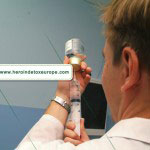 Ultra rapid detoxification from opioids (opiate) is a contemporary method of detoxification from opioids (heroin, methadone, oxycontin, tramadol, substitol, morphine sulfate, codeine, fentanyl, percocet, vicodin). Basic principle of this method, also known as Weisman method, is to rapidly purify opioid receptors from narcotics using antagonists. This process would naturally take from several days to two-three weeks to complete, but it can be significantly accelerated with the use of naloxone or implant. Therefore, alternative name for this treatment is Accelerated Opiate Neuro-Regulation Rapid Detox or Accelerated Opiate Detox. Naloxone or implant shorten duration of apstinential syndrome, but intensify its symptoms. For that reason, it is important to protect patient from the stress caused by purification of opioid receptors. Patient is under anesthesia and cannot feel the pain, patient`s brain structures are in the state of deep sleep, and special apparatus controls all the physiological processes. Contemporary anesthesia is safe: Medicaments used in the procedure are very efficient, they do not deposit in human body and they do not cause damage to kidneys or liver. Waking up after anesthesia is much easier and recovery is much faster. There is no nausea, muscle shivering, and at the same time physical strength returns very soon.
Ultra rapid detoxification from opioids (opiate) is a contemporary method of detoxification from opioids (heroin, methadone, oxycontin, tramadol, substitol, morphine sulfate, codeine, fentanyl, percocet, vicodin). Basic principle of this method, also known as Weisman method, is to rapidly purify opioid receptors from narcotics using antagonists. This process would naturally take from several days to two-three weeks to complete, but it can be significantly accelerated with the use of naloxone or implant. Therefore, alternative name for this treatment is Accelerated Opiate Neuro-Regulation Rapid Detox or Accelerated Opiate Detox. Naloxone or implant shorten duration of apstinential syndrome, but intensify its symptoms. For that reason, it is important to protect patient from the stress caused by purification of opioid receptors. Patient is under anesthesia and cannot feel the pain, patient`s brain structures are in the state of deep sleep, and special apparatus controls all the physiological processes. Contemporary anesthesia is safe: Medicaments used in the procedure are very efficient, they do not deposit in human body and they do not cause damage to kidneys or liver. Waking up after anesthesia is much easier and recovery is much faster. There is no nausea, muscle shivering, and at the same time physical strength returns very soon.
 Anesthesia is often compared to airplane flight. A hundred years ago it was a mean of transportation that involved certain degree of risk, but today people fly two or three times a month without any concerns. Anesthesia is becoming increasingly important in medicine. It has become a standard to perform unpleasant procedures such as colonoscopy, gastroscopy, bronchoscopy and biopsy under anesthesia. Treatment of teeth under anesthesia is also an usual procedure.
Anesthesia is often compared to airplane flight. A hundred years ago it was a mean of transportation that involved certain degree of risk, but today people fly two or three times a month without any concerns. Anesthesia is becoming increasingly important in medicine. It has become a standard to perform unpleasant procedures such as colonoscopy, gastroscopy, bronchoscopy and biopsy under anesthesia. Treatment of teeth under anesthesia is also an usual procedure.
There are, of course, certain indications and contraindications in case of ultra rapid detoxification.
Evaluation of risk, preparation, appropriate monitoring during the procedure, readiness to undertake necessary changes in course of anesthesia, and patient monitoring after the narcosis are absolutely necessary.
Method of rapid opiate detoxification is designed for patients:
- Who use high dosage of heroin or use opioids with long-term effects (methadone, oxycontin, substitol)
- Who feel strong desire for narcotics, and who feel that stay in clinics and becoming sober is too unpleasant experience.
- Who have decided to start implant therapy or use implant right after the detoxification procedure
Opiate rapid detox treatment is not for:
- Patients who have decompensated somatic disorders
- Elderly patients
- Women during pregnancy and breastfeeding
- Patients with acute infection
- Patients with thrombosis risk (previous preparation is necessary)
The technique is based on four-phase procedure:
1. Medical evaluation of a patient and preparing a plan of anesthesia. Anesthesiologist interviews and examines a patient determining details about dosage, length of addiction and way of intake of opioids, overall health condition, allergic reactions, and previous anesthesia procedures. Blood pressure checks, saturation, ECG and physical check are undertaken. Patients also undergo HIV, hepatitis, blood biochemical and other general tests.
2. Preparation – patient receives therapy for prevention of withdrawal syndrome, infusion for rehydration, sedation and anxiolytics for nervous tension relief.
3. Ultra-rapid detoxification procedure is carried out in a room with all the necessary equipment: monitors, devices for artificial breathing, oxygenation, defibrillation and arrhythmia correction. After the preparation and start of monitoring, there is induction of anesthesia with the use of intravenous anesthetics or gas. Maintenance of anesthesia is controlled by special devices that determine dosages of hypnotics, analgetics and substances for neurovegetative protection. Monitoring and constant registration of ECG, artery pressure, pulse and oxygen levels are also compulsory. Reaction to implant (naloxone) is also controlled. Procedure usually lasts six to seven hours.
4. Period after the narcosis – patient remains under monitoring until full awakening. After evaluation and doctor`s approval, patient is allowed to eat, drink, watch TV, communicate with other patients, but still receives intensive treatment. During the following day, tests are run to see how many opioid receptors have been purified and if there is a need for additional procedure. In case of absence of opioids in urine, and negative result on test dose of implant , patient is ready for naltrex implant procedure.
If you have any question about rapid drug detox , contact us for free consultation.
You can call us: +44 330 777 1482.
Vorobiev clinic is open to patients from all over the world, suffering from alcoholism and all kind of drug addiction. We helped thousands of patients from all over the world : Canada, Ireland, UK, Norway, Pakistan, Turkey, Iceland, Poland , Australia, Egypt, Hong Kong, Germany…See what other patients have to say about our international addiction clinic.










